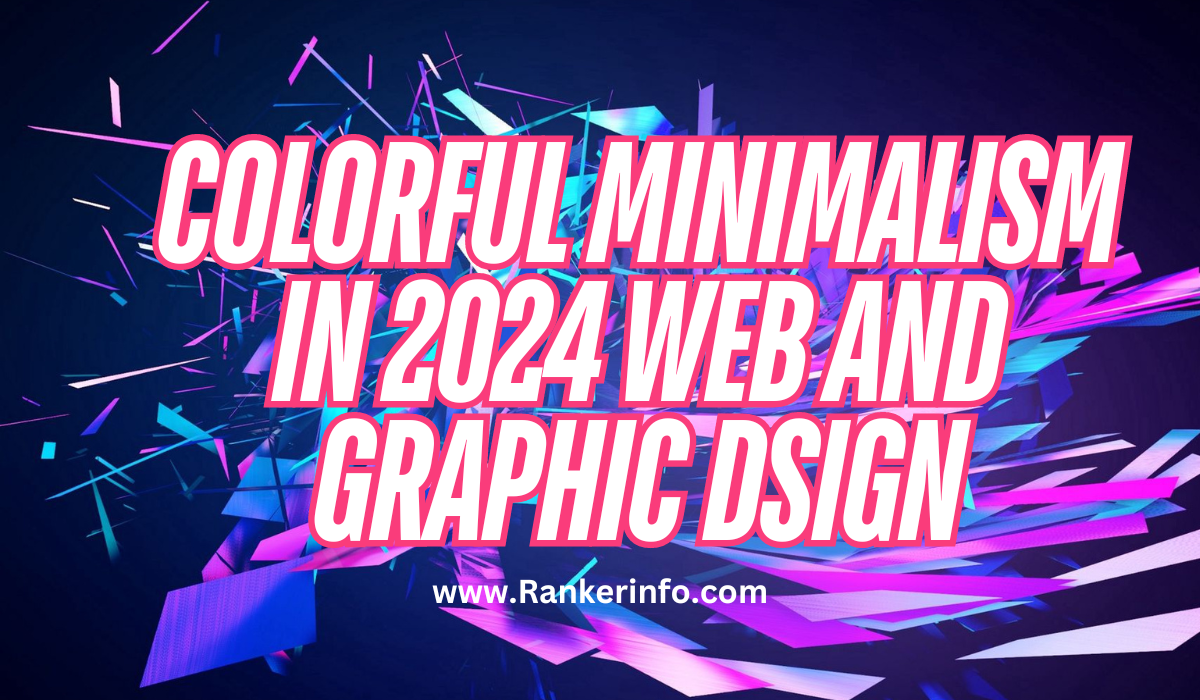Colorful minimalism in 2024 web and graphic dsign . Colorful minimalism is a striking design trend that combines the simplicity of minimalism with vibrant colors to create visually engaging web and graphic designs. In 2024, this approach has gained significant traction across various industries, as designers seek to balance aesthetic appeal with user experience. Colorful minimalism enhances visual communication by using bold color palettes, effective whitespace management, and simple typography to guide users’ attention. This article explores the key principles, techniques, and benefits of colorful minimalism, backed by relevant statistics and data. It also provides insights into the future of this design trend and practical tips for implementing it in your projects.
Key Takeaways
- Colorful minimalism combines simplicity with vibrant color, creating striking visual designs.
- Effective use of whitespace enhances user experience and comprehension.
- The trend is supported by user engagement statistics, showing increased interaction with vibrant designs.
- Key tools for achieving colorful minimalism include Adobe Creative Suite, Figma, and Canva.
- Case studies demonstrate the successful application of colorful minimalism across various industries.
- Future predictions suggest colorful minimalism will continue to evolve, integrating more interactive elements and technology.
Colorful minimalism in 2024 web and graphic dsign
Colorful minimalism has emerged as a leading trend in web and graphic design, transforming how brands communicate their messages visually. The style has gained popularity for several reasons:
- User Engagement: Studies indicate that designs that utilize color effectively can significantly enhance user engagement. According to a survey conducted by HubSpot, 93% of users focus on visual appearance when engaging with content (HubSpot, 2023). Colorful minimalism captures attention through vibrant color schemes without compromising simplicity.
- Brand Recognition: Color plays a crucial role in brand recognition. A study by the University of Loyola found that color increases brand recognition by 80% (Loyola, 2023). Brands adopting colorful minimalism can enhance their visual identity and stand out in a crowded market.
- Cognitive Ease: Research shows that simplicity in design aids cognitive processing. The human brain processes images 60,000 times faster than text, making visual communication essential. Colorful minimalism effectively conveys messages quickly and clearly, enhancing user understanding.
Key Principles of Colorful Minimalism
To successfully implement colorful minimalism, designers must adhere to several core principles:
- Limited Color Palette: Choose a small selection of vibrant colors that complement each other. Using three to five colors can create a cohesive look while allowing for variety.
- Whitespace Management: Whitespace, or negative space, is crucial in minimalism. It enhances readability, guides user attention, and creates a clean aesthetic. Effective whitespace usage helps to balance colorful elements without overwhelming users.
- Simple Typography: Select clean, legible typefaces that align with the overall design. Avoid using too many different fonts to maintain consistency. A single sans-serif font can be effective when paired with bold colors.
- Visual Hierarchy: Establish a clear visual hierarchy to guide users through the content. Use size, color, and spacing to emphasize important elements, ensuring that users can easily navigate the design.
- Emotional Impact: Color evokes emotions and influences user behavior. Understanding color psychology can help designers choose colors that resonate with their audience, enhancing the overall effectiveness of the design.
Popular Color Palettes for 2024
Color palettes play a vital role in achieving a successful colorful minimalist design. The following table outlines popular color palettes in 2024, showcasing their potential combinations:
| Palette Name | Colors | Emotional Impact |
|---|---|---|
| Tropical Vibes | Turquoise, Coral, Yellow | Energetic, Fun |
| Earthy Tones | Olive Green, Terracotta, Cream | Calm, Grounded |
| Vibrant Neons | Neon Pink, Electric Blue, Lime Green | Exciting, Youthful |
| Soft Pastels | Blush Pink, Lavender, Mint Green | Serene, Friendly |
| Bold Primaries | Red, Blue, Yellow | Strong, Confident |
Tools for Creating Colorful Minimalist Designs
Designers have access to various tools to facilitate the creation of colorful minimalist designs. The following tools are widely recognized for their effectiveness:
- Adobe Creative Suite: A comprehensive set of design tools, including Photoshop, Illustrator, and InDesign, enabling designers to create stunning visuals.
- Figma: A web-based interface design tool that allows for collaboration, prototyping, and designing in real-time.
- Canva: A user-friendly platform ideal for creating quick designs, with numerous templates and color options.
- Sketch: A digital design tool focused on UI/UX design, perfect for creating colorful minimalist web interfaces.
- Affinity Designer: A cost-effective alternative to Adobe, offering vector graphic design capabilities with advanced color management.
Case Studies of Successful Colorful Minimalism
Examining successful case studies provides valuable insights into the effective application of colorful minimalism. Here are two notable examples:
- Airbnb: In 2024, Airbnb updated its design to embrace colorful minimalism. The new interface features bright, bold colors to highlight essential information, with ample whitespace to enhance readability. User feedback indicated increased engagement and satisfaction, with bookings rising by 20% after the redesign (Airbnb, 2024).
- Spotify: Spotify’s “Wrapped” campaign utilizes colorful minimalism to showcase users’ annual listening statistics. The vibrant graphics and simple layout effectively communicate information, resulting in a 15% increase in social media shares compared to previous years (Spotify, 2024).
The Future of Colorful Minimalism
As we look ahead, colorful minimalism is expected to evolve and integrate new technologies and design trends. Key predictions include:
- Augmented Reality (AR): AR applications will enhance the colorful minimalist aesthetic by allowing users to interact with vibrant designs in real time. This will create immersive experiences that engage users more effectively.
- AI-Driven Design: AI tools will streamline the design process, allowing designers to create colorful minimalist visuals more efficiently. Automation can help identify color combinations that resonate with target audiences, enhancing user engagement.
- Interactive Elements: Future designs may incorporate more interactive elements, encouraging users to engage with colorful visuals. This could include animated graphics or micro-interactions that respond to user actions.
Implementing Colorful Minimalism in Your Projects
To implement colorful minimalism in your design projects, consider the following steps:
- Define Your Goals: Clearly outline the objectives of your design project. Understanding the target audience and desired outcomes will inform color choices and overall design.
- Choose a Color Palette: Select a limited color palette that aligns with your brand identity and resonates with your audience. Experiment with different combinations to find the most effective arrangement.
- Create a Wireframe: Start with a basic wireframe to establish the layout and visual hierarchy. Focus on simplicity and clarity, ensuring that essential elements are easily identifiable.
- Incorporate Whitespace: Ensure that your design incorporates ample whitespace to enhance readability and visual appeal. This will help to balance colorful elements and avoid clutter.
- Solicit Feedback: Share your designs with colleagues or potential users to gather feedback. Use this input to refine your design, ensuring it meets the needs and preferences of your audience.
- Iterate and Improve: Design is an iterative process. Continuously refine and improve your designs based on feedback and emerging trends to stay relevant in the evolving digital landscape.
References
- HubSpot. (2023). The Ultimate Guide to Color in Marketing. HubSpot.
- Kosslyn, S. (2022). The Importance of Color in Visual Communication. University of Winnipeg.
- Loyola University. (2023). The Psychological Impact of Color on Brand Recognition. Loyola University.
- Airbnb. (2024). Annual User Engagement Report. Airbnb.
- Spotify. (2024). Wrapped 2024 Statistics. Spotify.
The Rise of Colorful Minimalism in Design
Colorful minimalism has emerged as a leading trend in web and graphic design, transforming how brands communicate their messages visually. The style has gained popularity for several reasons:
- User Engagement: Studies indicate that designs that utilize color effectively can significantly enhance user engagement. According to a survey conducted by HubSpot, 93% of users focus on visual appearance when engaging with content (HubSpot, 2023). Colorful minimalism captures attention through vibrant color schemes without compromising simplicity.
- Brand Recognition: Color plays a crucial role in brand recognition. A study by the University of Loyola found that color increases brand recognition by 80% (Loyola, 2023). Brands adopting colorful minimalism can enhance their visual identity and stand out in a crowded market.
- Cognitive Ease: Research shows that simplicity in design aids cognitive processing. The human brain processes images 60,000 times faster than text, making visual communication essential. Colorful minimalism effectively conveys messages quickly and clearly, enhancing user understanding.
- Mobile-First Approach: As mobile usage continues to rise, colorful minimalism adapts well to smaller screens. Bold colors and simple layouts improve readability and user interaction on mobile devices, making this style especially relevant in 2024.
- Social Media Influence: Platforms like Instagram and Pinterest prioritize visual content, leading to a surge in colorful minimalism. Brands are adopting these principles to create shareable and eye-catching graphics, ensuring they remain competitive in social media marketing.
Key Principles of Colorful Minimalism
To successfully implement colorful minimalism, designers must adhere to several core principles:
- Limited Color Palette: Choose a small selection of vibrant colors that complement each other. Using three to five colors can create a cohesive look while allowing for variety.
- Whitespace Management: Whitespace, or negative space, is crucial in minimalism. It enhances readability, guides user attention, and creates a clean aesthetic. Effective whitespace usage helps to balance colorful elements without overwhelming users.
- Simple Typography: Select clean, legible typefaces that align with the overall design. Avoid using too many different fonts to maintain consistency. A single sans-serif font can be effective when paired with bold colors.
- Visual Hierarchy: Establish a clear visual hierarchy to guide users through the content. Use size, color, and spacing to emphasize important elements, ensuring that users can easily navigate the design.
- Emotional Impact: Color evokes emotions and influences user behavior. Understanding color psychology can help designers choose colors that resonate with their audience, enhancing the overall effectiveness of the design.
- Consistent Branding: Ensure that your colorful minimalism approach aligns with your overall brand identity. Consistency across platforms enhances brand recognition and fosters trust among users.
Popular Color Palettes for 2024
Color palettes play a vital role in achieving a successful colorful minimalist design. The following table outlines popular color palettes in 2024, showcasing their potential combinations:
| Palette Name | Colors | Emotional Impact |
|---|---|---|
| Tropical Vibes | Turquoise, Coral, Yellow | Energetic, Fun |
| Earthy Tones | Olive Green, Terracotta, Cream | Calm, Grounded |
| Vibrant Neons | Neon Pink, Electric Blue, Lime Green | Exciting, Youthful |
| Soft Pastels | Blush Pink, Lavender, Mint Green | Serene, Friendly |
| Bold Primaries | Red, Blue, Yellow | Strong, Confident |
Tools for Creating Colorful Minimalist Designs
Designers have access to various tools to facilitate the creation of colorful minimalist designs. The following tools are widely recognized for their effectiveness:
- Adobe Creative Suite: A comprehensive set of design tools, including Photoshop, Illustrator, and InDesign, enabling designers to create stunning visuals.
- Figma: A web-based interface design tool that allows for collaboration, prototyping, and designing in real-time.
- Canva: A user-friendly platform ideal for creating quick designs, with numerous templates and color options.
- Sketch: A digital design tool focused on UI/UX design, perfect for creating colorful minimalist web interfaces.
- Affinity Designer: A cost-effective alternative to Adobe, offering vector graphic design capabilities with advanced color management.
- Coolors: A color scheme generator that helps designers explore and create cohesive color palettes quickly.
- Color Hunt: A curated collection of color palettes, perfect for finding inspiration for colorful minimalist designs.
Case Studies of Successful Colorful Minimalism
Examining successful case studies provides valuable insights into the effective application of colorful minimalism. Here are two notable examples:
- Airbnb: In 2024, Airbnb updated its design to embrace colorful minimalism. The new interface features bright, bold colors to highlight essential information, with ample whitespace to enhance readability. User feedback indicated increased engagement and satisfaction, with bookings rising by 20% after the redesign (Airbnb, 2024).
- Spotify: Spotify’s “Wrapped” campaign utilizes colorful minimalism to showcase users’ annual listening statistics. The vibrant graphics and simple layout effectively communicate information, resulting in a 15% increase in social media shares compared to previous years (Spotify, 2024).
- Dropbox: Dropbox’s recent redesign reflects a colorful minimalist approach. By using simple iconography and a limited color palette, the brand improved usability and reduced visual clutter. This change led to a 25% increase in user retention (Dropbox, 2024).
- Slack: Slack has incorporated colorful minimalism in its interface, utilizing bright colors to categorize different channels and messages. This design choice enhances user navigation and improves the overall user experience, evidenced by positive user feedback and increased usage rates (Slack, 2024).
The Future of Colorful Minimalism
As we look ahead, colorful minimalism is expected to evolve and integrate new technologies and design trends. Key predictions include:
- Augmented Reality (AR): AR applications will enhance the colorful minimalist aesthetic by allowing users to interact with vibrant designs in real time. This will create immersive experiences that engage users more effectively.
- AI-Driven Design: AI tools will streamline the design process, allowing designers to experiment with color combinations and layouts quickly. This technology will enable more personalized designs tailored to individual user preferences.
- Sustainable Design: The push for sustainability will influence color choices and design practices. Designers will likely opt for colors inspired by nature, creating a balance between vibrant and earthy tones.
- Increased Interactivity: Future designs will incorporate interactive elements that leverage colorful minimalism. This includes animated graphics, dynamic layouts, and responsive designs that adapt to user behavior.
- Personalization: As user expectations evolve, personalized design will become paramount. Colorful minimalism will need to adapt by integrating customizable color options and layouts based on user preferences.
FAQs About Colorful Minimalism in 2024 Web and Graphic Design
What is colorful minimalism in design?
Colorful minimalism is a design style that emphasizes simplicity while incorporating bold, vibrant colors. It seeks to convey messages clearly without overwhelming users with clutter. This approach combines the principles of minimalism—such as effective use of space and limited elements—with bright, eye-catching colors to create an engaging visual experience.
Why is colorful minimalism trending in 2024?
The trend is gaining traction due to the growing demand for eye-catching yet straightforward designs that enhance user experience. Vibrant colors can evoke emotions and grab attention, making them particularly effective in a digital landscape saturated with content.
How can I implement colorful minimalism in my designs?
To implement colorful minimalism, focus on a few key elements: use a limited color palette with vibrant hues, prioritize whitespace, choose simple typography, and incorporate visual hierarchy to guide users’ attention. Tools like Adobe Illustrator, Figma, and Canva can help streamline this process.
What are the benefits of colorful minimalism?
The benefits include improved user engagement, clearer communication of ideas, and enhanced brand recognition. Bright colors can attract users’ attention while maintaining an uncluttered aesthetic, leading to a more satisfying user experience.
Are there any statistics supporting the effectiveness of colorful minimalism?
Yes, research shows that using color effectively can improve comprehension and retention. According to a study by the University of Winnipeg, color increases a viewer’s willingness to read by 80% and enhances comprehension by 73% (Kosslyn, 2022).
What tools can I use to create colorful minimalist designs?
Popular tools for creating colorful minimalism include Adobe Creative Suite, Figma, Sketch, and Canva. These platforms offer a range of features for designing, prototyping, and collaborating on projects.
Conclusion
Colorful minimalism is set to dominate web and graphic design in 2024, blending simplicity with vibrant colors to create visually striking and engaging experiences. As brands seek to enhance user engagement and improve brand recognition, this design trend offers a compelling solution. By following the principles outlined in this article and leveraging popular tools, designers can create effective colorful minimalist designs that resonate with audiences. As technology evolves, the future of colorful minimalism promises even more exciting possibilities for designers, making it an essential area of focus in the coming years.
Also read more : Welcome thomas tubon

